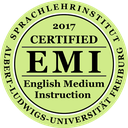Insights from the Territory and Biocultural Ancestral Medicine of the Kamëntsá Biya People workshop: bringing knowledges together
When I hear terms like “Ancestral Medicine” or “Indigenous Medicine” I as a Central European automatically think of medicinal herbs and plants, curing diseases or helping with pain. I didn’t realize that this understanding of medicine is narrow, probably based on the fact that I never actually had contact with ancestral medicine: My knowledge on this topic only stemmed from the depictions and explanations I stumbled across in my life.
That is the reason why I expected to learn about medicinal plants, maybe getting a list or pictures of them, with explanations how they worked and what they cured, when I walked into the workshop “Territory and Biocultural Ancestral Medicine of the Kamëntsá Biya People”. But instead, the workshop turned out to be a very personal journey, giving me a new perspective on my own body and my environment.
The workshop – co-organised by Dr. Cristina Espinosa, La Olla Colectivo & Corporación Jajañ – was held by Loly Nereida Juajibioy Muchachasoy, a sociologist and gender specialist, and Taita Carlos Juajibioy Jacanamejoy, a traditional healer and spiritual authority of the Kamëntsá Biya People. Through starting rituals including locating us in the four cardinal points and a presentation, we were introduced to the ontology, life, language, and traditions of their community stemming from Tabanok – a territory at the Andean-Amazonian foothills in Colombia. By sharing insights into their everyday life, sacred spaces and entities, and cultural practices they drew a vivid picture of a reality so different from the lecture room in Freiburg we were sitting in.
During the presentation Loly Nereida and Taita Carlos also explained the organizational structures of medicine in their community, something that surprised me, again emphasizing my lack of knowledge and stereotypical idea of the medicine being centered in one wise person. Instead, we learned that there are different people with different responsibilities and specializations. But this was not the only surprising thing for me: They explained their biocultural medicine, how medicine is not only about healing diseases of the body. Instead, it is deeply intertwined with the territory. Balance is pursued not only within the body – the relation between feeling and knowing/thinking (“sentipensar”) - but between body, land, spirituality, and territoriality.
This balance was also the topic of the second part of the workshop, where we first used the community feminist technique of body mapping individually, and afterwards a Participatory Action Research (PAR) technique of mapping changes in our territory in small groups. This exercise helped to explore the balance within our bodies as well as our relationship with and influence of and on our territories. In the body mapping we explored our pains (“dolores”) and sufferings (“sufrimientos”) by drawing them onto our bodies. Again, I experienced a sense of lack of understanding due to a privileged Central European life: What can I (and probably many other people in the same room) write about suffering? Pains, in the sense of emotional or physical pain, that is easier to grasp, to write down on a sheet of paper. But when do we actually experience sufferings? I think this is a question that might be hard to answer for many white Europeans, at least for myself it was.
Another big learning was brought by the second exercise: When attempting to map our “territory”, we (a German group) realized, that for us it is not easy to say what our territory is. Is it where we grew up, went to school, or where we live for studying or working? When does a place become one’s “territory”? How close are we really with our surrounding water bodies, lands, and forests? These overarching questions showed me, that in my lived experience and lifestyle, this sense of connection to a place is so different to people like the some of the Kamëntsá Biya who have an ancestral connection to the land, the territory, they live with.
I am grateful to Loly Nereida Juajibioy Muchachasoy, Taita Carlos Juajibioy Jacanamejoy, and the organizing team to have come in contact with this different world of knowledge, to question my understandings and to widen my perspectives on the definition of "medicine".
Lisa Fritsch


